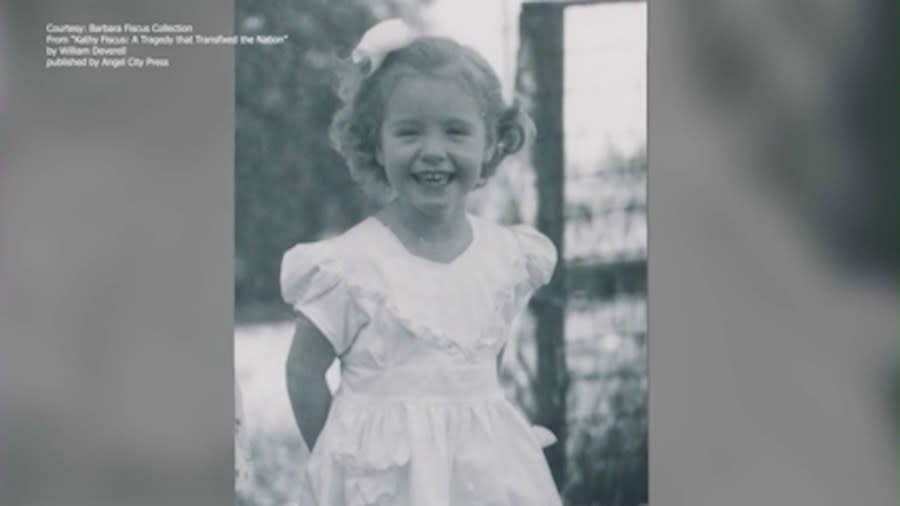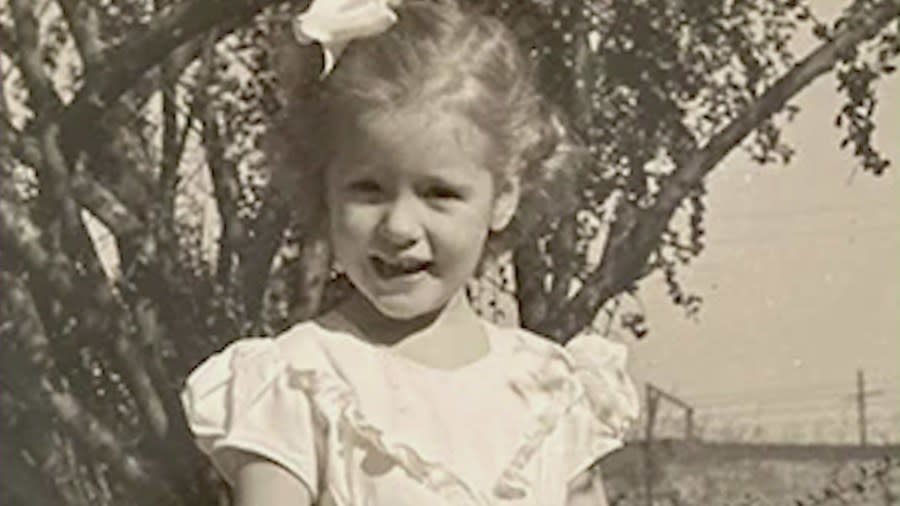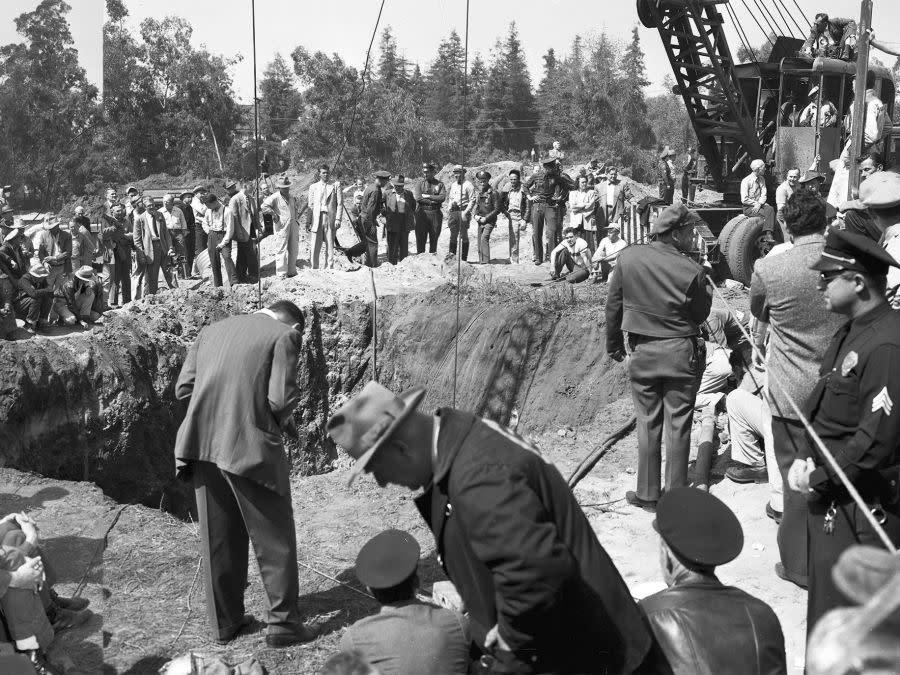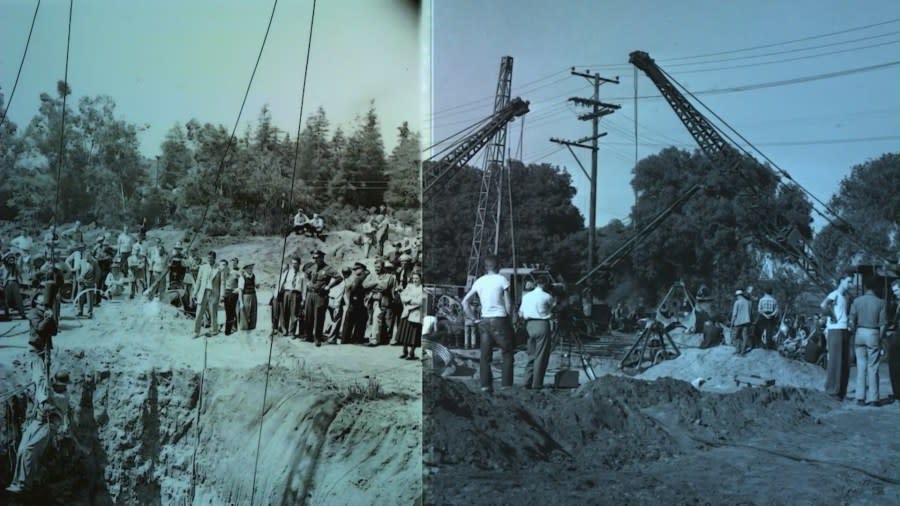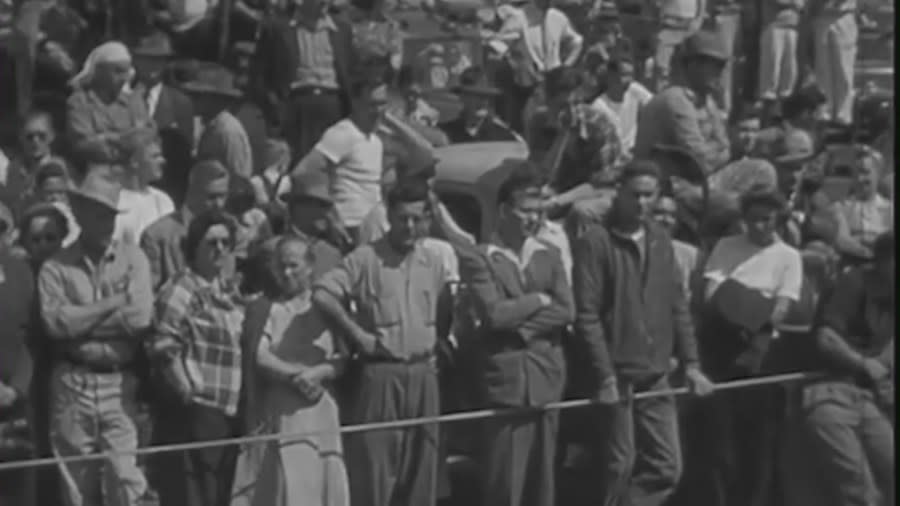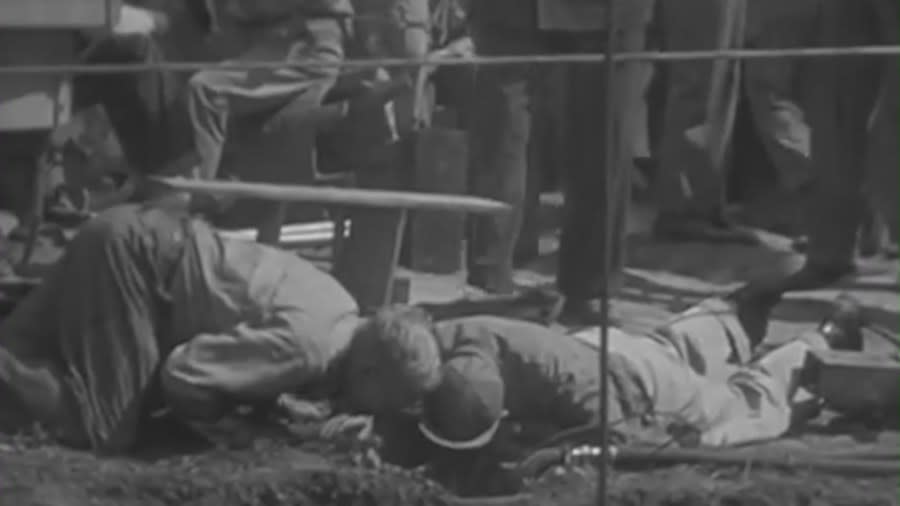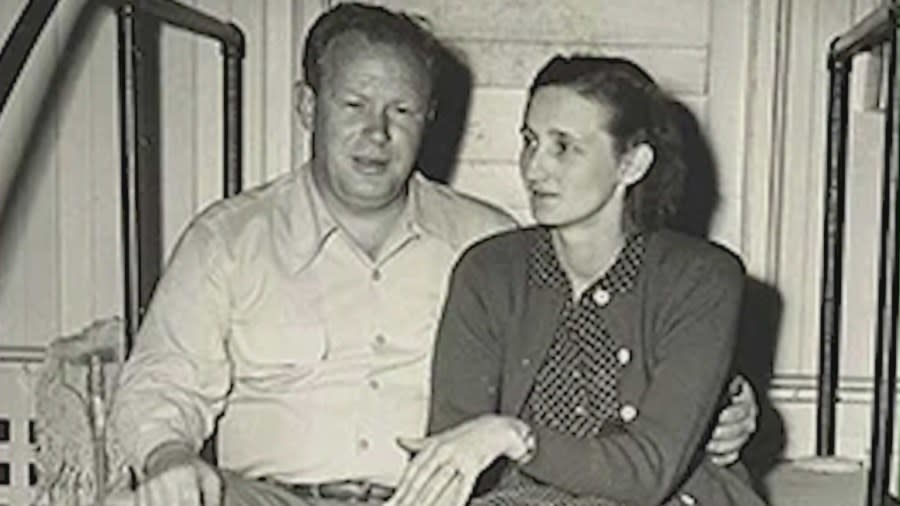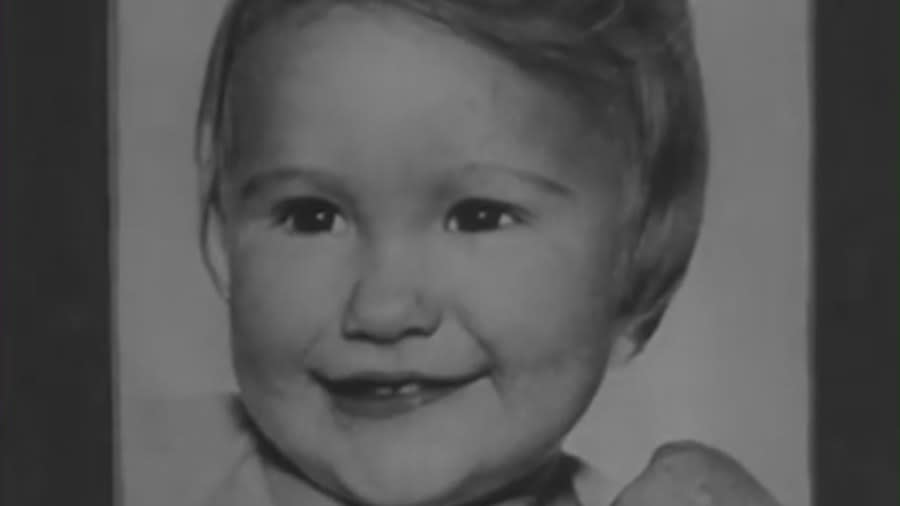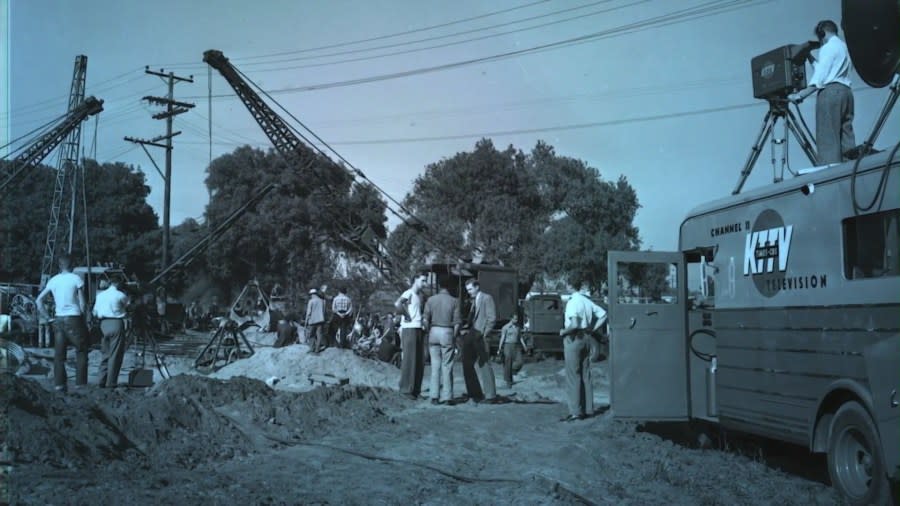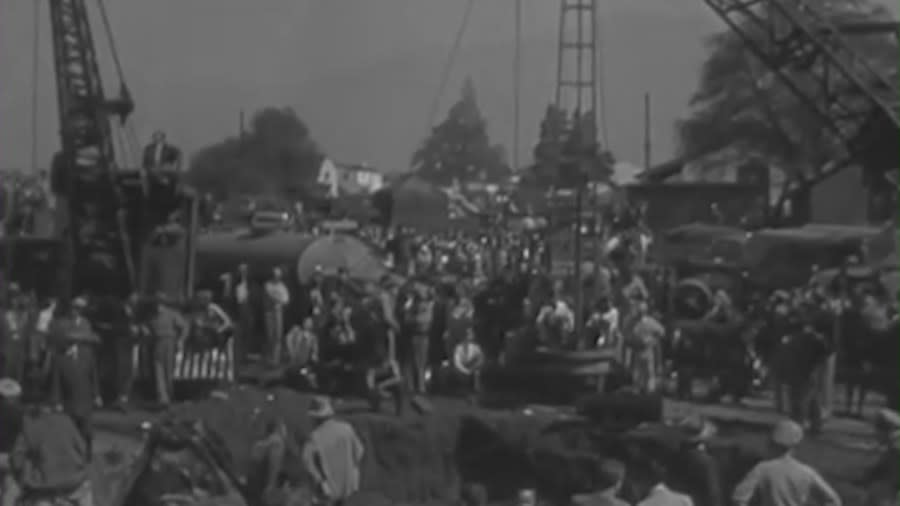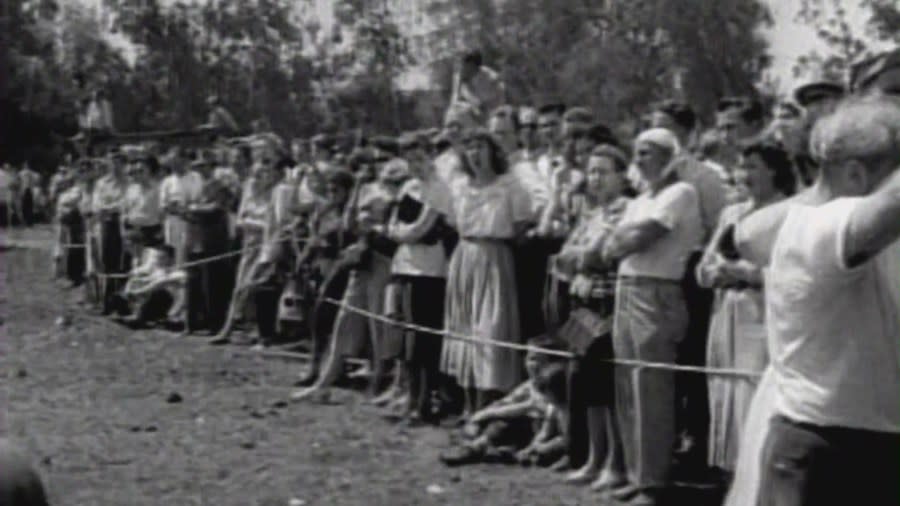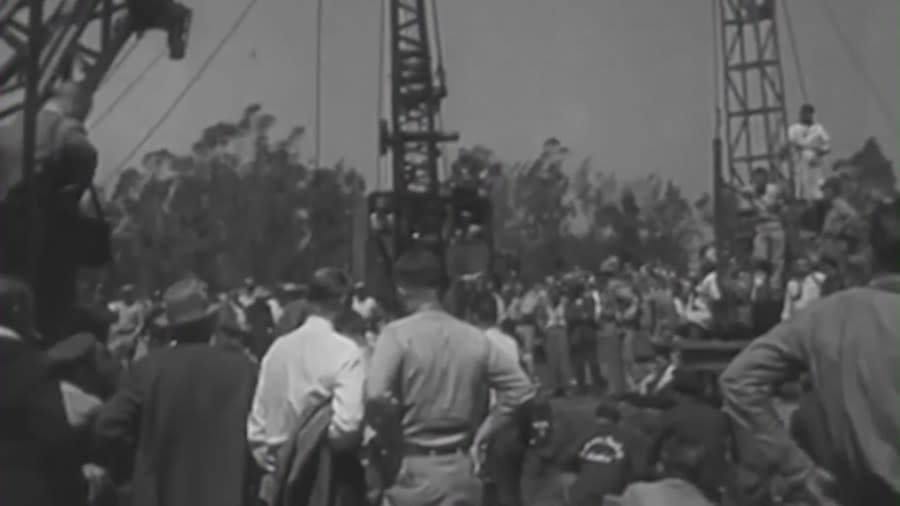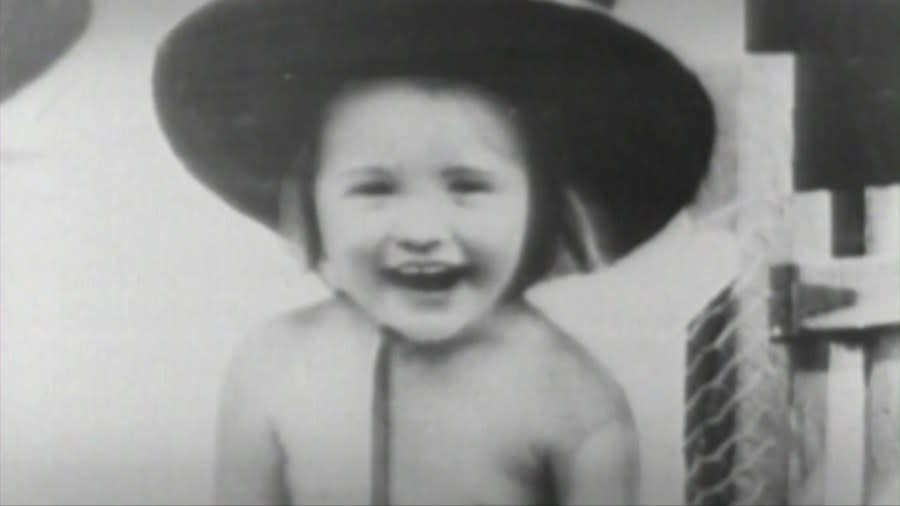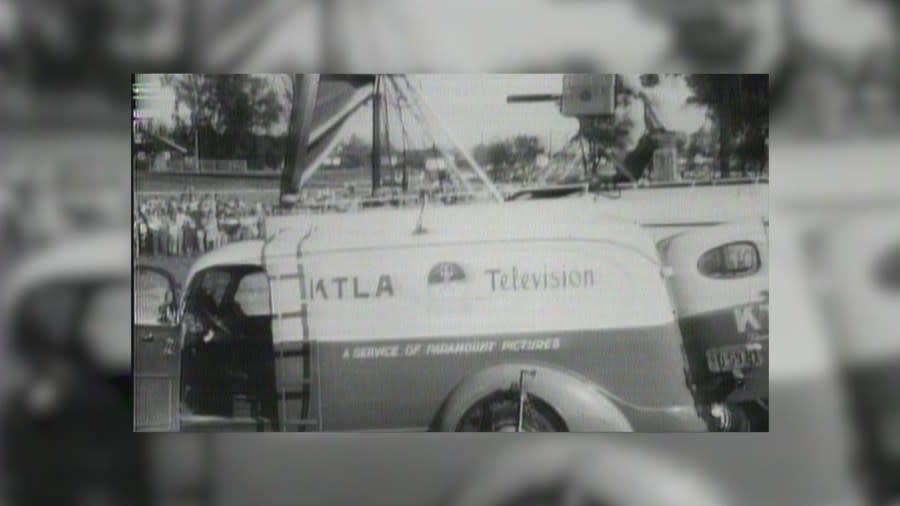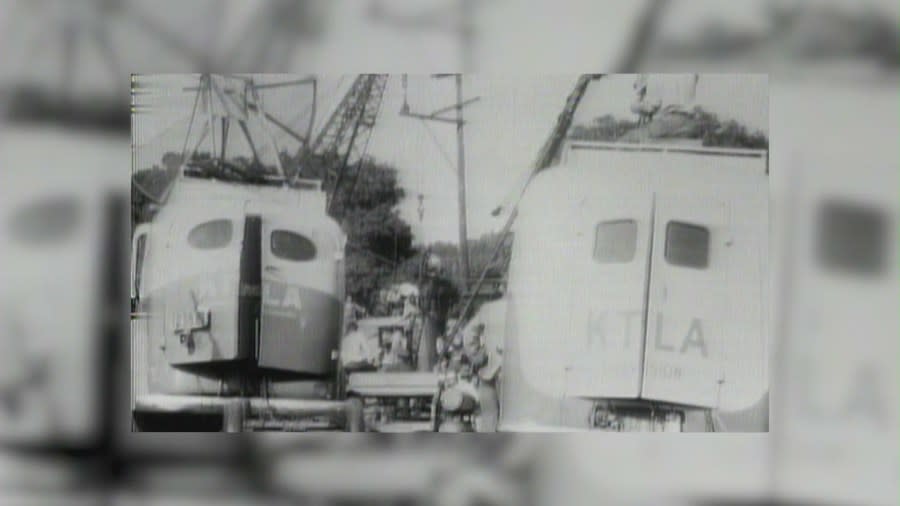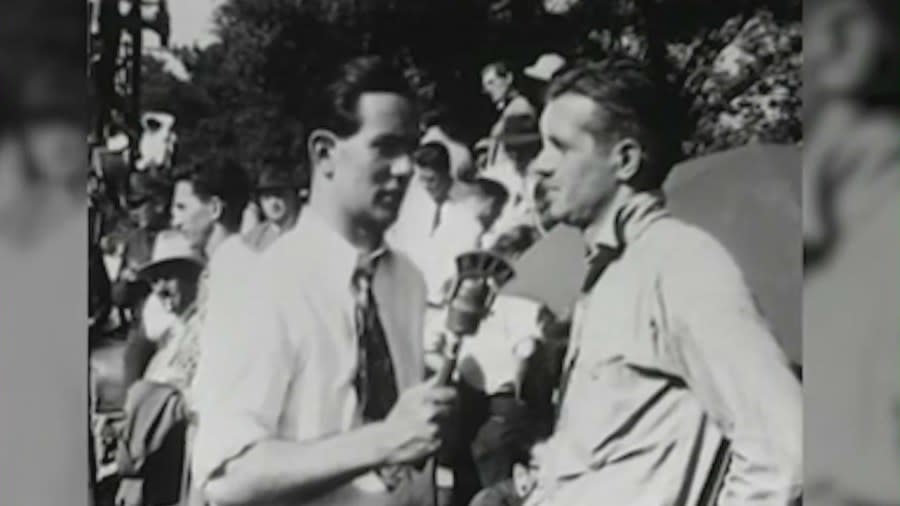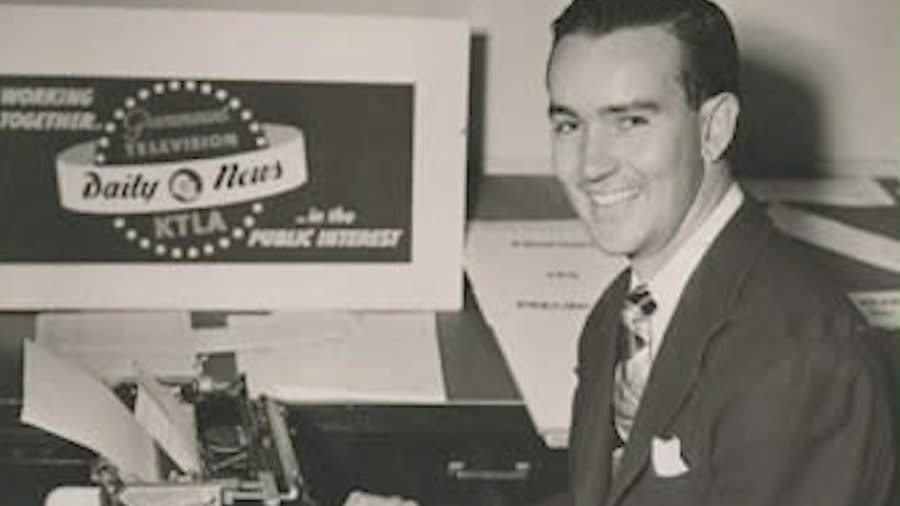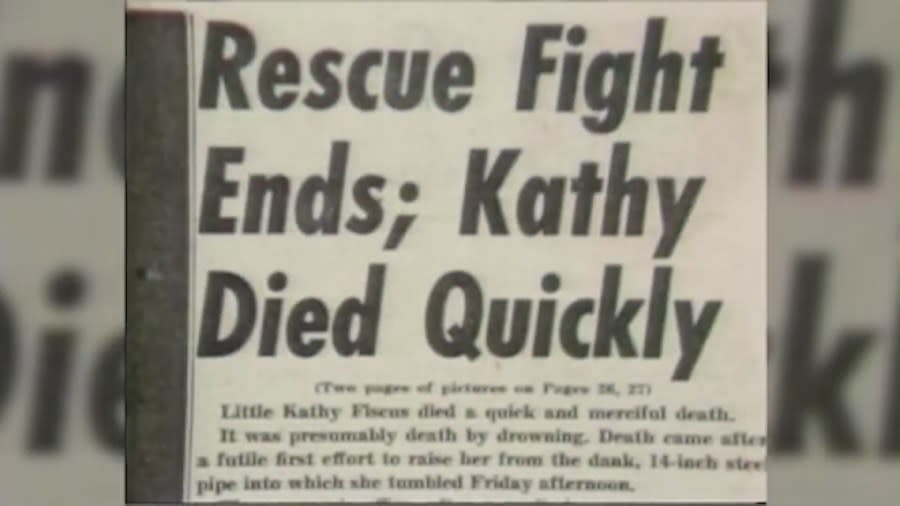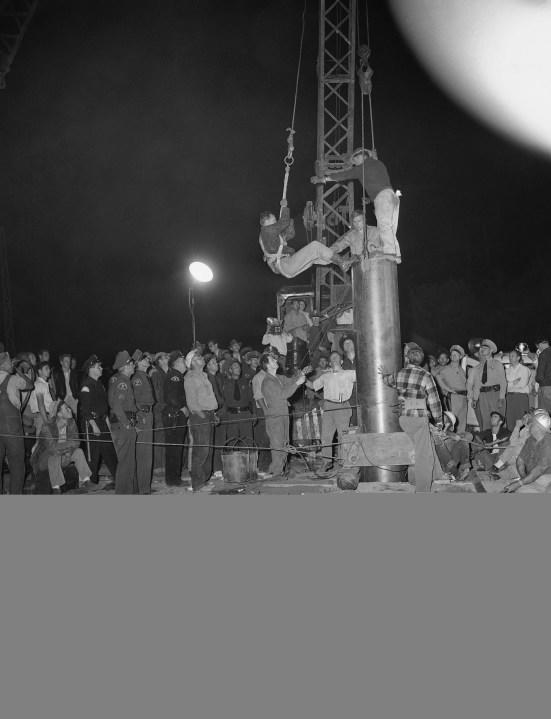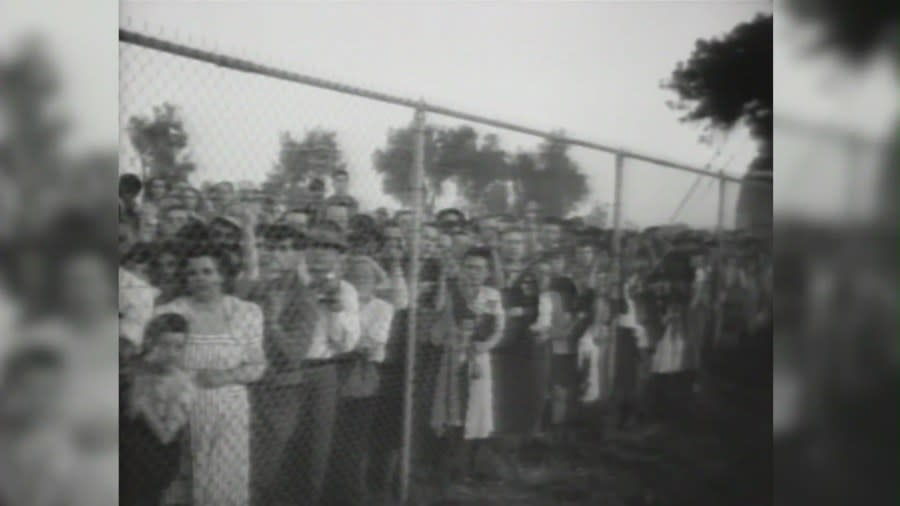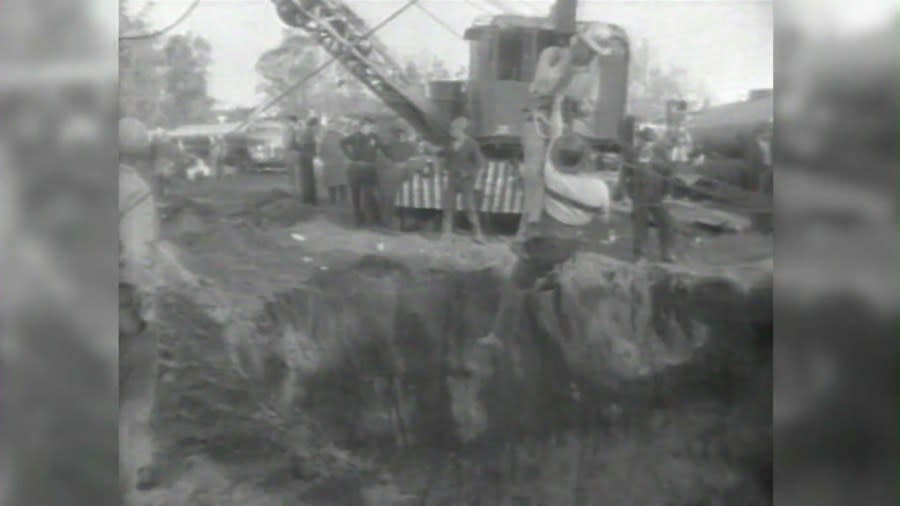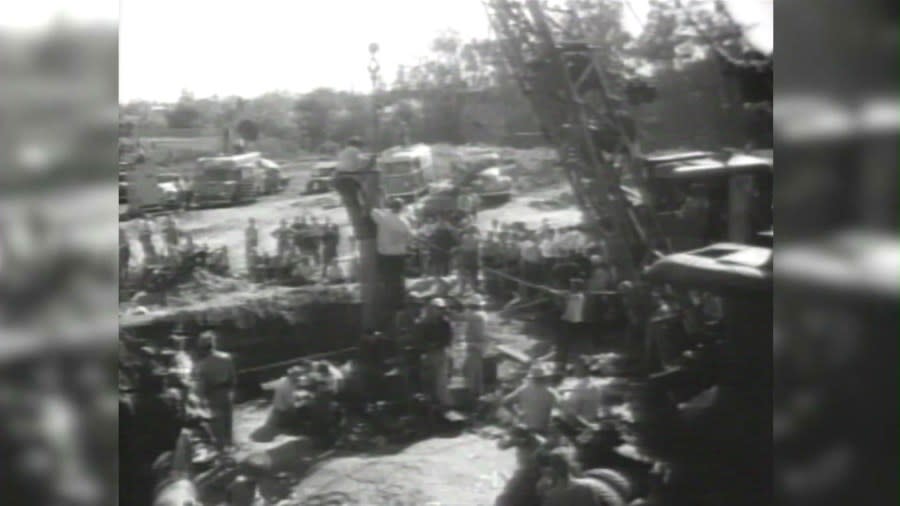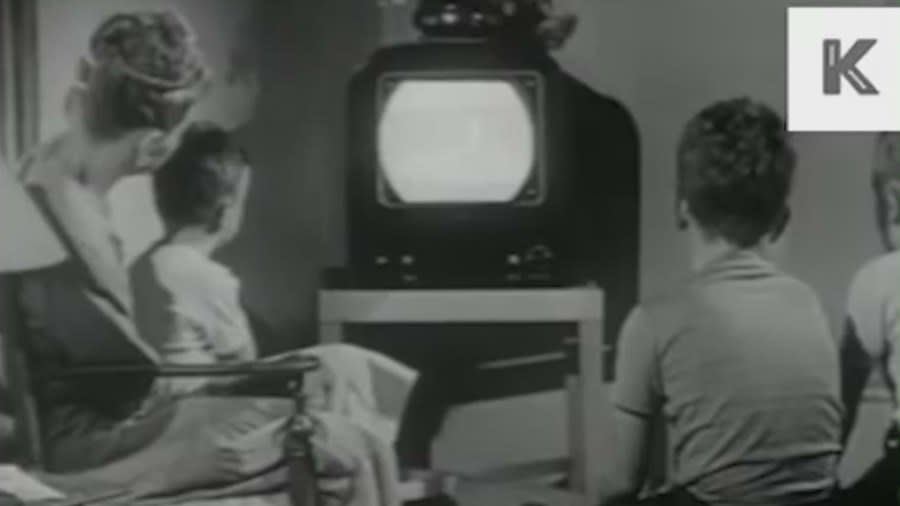Kathy Fiscus Tragedy in San Marino: 75 years later
It’s been 75 years since 3-year-old Kathy Fiscus fell into a well in San Marino and her attempted rescue transfixed the nation.
On April 8, 1949, Kathy had been running around her family’s backyard, playing with her sister and cousins. When her mother looked up to check on her, the girl suddenly vanished from view.
Kathy had fallen 90 feet into an abandoned well and remained trapped in a long vertical pipe about 14 inches wide.
As emergency crews scrambled to the scene, bulldozers, firemen, well diggers and anyone who could potentially help rescue the girl, offered their assistance.
Film studio Twentieth Century Fox donated a set of movie lights to help illuminate the rescue scene, according to the Los Angeles Times.
The multi-day rescue effort gripped the nation as KTLA spearheaded live coverage of the story, marking the first live, breaking news event in television history. The event was also covered by newspapers and radio stations around the world.
Kathy Fiscus seen in a family photo. (Barbara Fiscus Collection) Kathy Fiscus seen in a family photo. (Barbara Fiscus Collection) Emergency crew members dig into the earth as 3-year-old Kathy Fiscus remains trapped 90 feet below in an abandoned well in San Marino, April 1949. (Los Angeles Times) Emergency crew members dig into the earth as 3-year-old Kathy Fiscus remains trapped 90 feet below in an abandoned well in San Marino, April 1949. (Los Angeles Times) Thousands of onlookers gathered at the San Marino well to watch the attempted rescue of Kathy Fiscus in April 1949. (KTLA) Emergency crew members dig into the earth as 3-year-old Kathy Fiscus remains trapped 90 feet below in an abandoned well in San Marino, April 1949. (KTLA) Kathy’s parents Mr. and Mrs. Fiscus. (Los Angeles Times) Kathy Fiscus seen in a family photo. (Barbara Fiscus Collection) April 9, 1949: Times-CBS Station KTTV provides live coverage of Kathy Fiscus rescue attempt. In 1949, The Times owned KTTV. (Los Angeles Times) Thousands of rescue members and local citizens gathered at the San Marino well to watch the attempted rescue of Kathy Fiscus in April 1949. (KTLA) Thousands of onlookers gathered at the San Marino well to watch the attempted rescue of Kathy Fiscus in April 1949. (KTLA) Thousands of rescue members and local citizens gathered at the San Marino well to watch the attempted rescue of Kathy Fiscus in April 1949. (KTLA) Kathy Fiscus seen in a family photo. (Barbara Fiscus Collection) KTLA news vans at the scene of the Kathy Fiscus rescue in San Marino, California in April 1949. (KTLA) KTLA news vans at the scene of the Kathy Fiscus rescue in San Marino, California in April 1949. (KTLA) KTLA’s Stan Chambers reports live from the scene of Kathy Fiscus’ attempted rescue in San Marino, California in April 1949. (KTLA) KTLA news anchor Stan Chambers. (KTLA) Kathy Fiscus is confirmed dead after a failed 50-hour rescue attempt on April 10. 1949. (KTLA) Dr. Robert McCullock clambers up the side of the rescue tube, minutes before he sent up word on April 10, 1949 from below in the abandoned well that Kathy Fiscus was dead. Fiscus, a three year old, was playing with some friends in an open field, when she fell into an open well on April 7, 1949 at San Marino, Cal. For more than 48 hours the disappearance of a small girl tugged at the nation’s heartstrings. Little Kathy Fiscus, trapped in the depths of an abandoned well was found dead after unprecedented rescue efforts. Here the doctor is hoisted into the tube for a 95-foot drop to what proved a scene of tragedy . (AP Photo/Harold Filan) Thousands of onlookers gathered at the San Marino well to watch the attempted rescue of Kathy Fiscus in April 1949. (KTLA) Emergency crew members dig into the earth as 3-year-old Kathy Fiscus remains trapped 90 feet below in an abandoned well in San Marino, April 1949. (KTLA) Emergency crew members dig into the earth as 3-year-old Kathy Fiscus remains trapped 90 feet below in an abandoned well in San Marino, April 1949. (KTLA) Family watching television in the 1950s. (KTLA)
KTLA’s coverage brought thousands of visitors to the scene, many offering advice to emergency crews in a desperate attempt to save Kathy.
“People cried, people held hands, people prayed,” said William Deverell, author of Kathy Fiscus: A Tragedy that Transfixed the Nation. “People slept on the lawns nearby. People climbed the oak trees to look at the rescue attempt. She falls 90 feet. The well itself actually snakes into the earth far deeper than that, but she’s stuck at about nine stories down and obviously terrified.”
First responders arriving at the scene could hear Kathy’s cries for help, her voice described as a child who sounded like she was stuck in a dark closet. Despite their efforts, the initial rescue attempt was a failure.
“Other plans were launched which include digging side-by-side holes in the earth next to the well and the hope is that perhaps they could reach down as far as she is, tunnel across, open up the well casing where she is and get her out,” Deverell said.
As rescue efforts continued well into the night, KTLA’s general manager, Klaus Landsberg, knew it was a chance for KTLA to make history and cover the story live.
“There’s a notion that perhaps remote television broadcasting can’t work,” Deverell said. “It’s an experiment. A lot of people think it won’t work.”
But Landsberg and his team of KTLA engineers managed to establish a live signal from the scene and, over 24 hours into the rescue operation, KTLA was officially live on the air.
“This would be the first time that people could just gather in front of a television set and see images of breaking news as it was happening,” said author and former KTLA anchor, Terry Anzur.
The decision resulted in over 27 hours of continuous live coverage from KTLA. The majority of the event was covered by announcer Bill Welsh and reporter Stan Chambers.
“We watched men go down and come up and buckets of dirt and sand come up and all of the rescue attempts being made,” Chambers is heard saying in 1949.
Chambers’ work was unprecedented and pioneered television coverage of breaking news without a script.
“He wasn’t really sure what to do, so he roamed around the site trying to get interviews and he had quite a story to tell,” Anzur said.
As rescue efforts entered the second day, Kathy’s parents tried desperately to remain positive. Many local cities were brought to a standstill as the few businesses with operating television sets stayed open all night so locals could watch the rescue.
In that era, very few households actually owned a television set.
“People would gather in front of televisions wherever they could find them,” Anzur said. “In front of department stores, if a neighbor had a TV, they would go there and camp out to find out what would happen to little Kathy.”
Just over 48 hours after the rescue began, the grim news was confirmed — Kathy had not survived the ordeal. As her family received the devastating update, the tragedy unfolding before a live television audience generated an indelible mark in modern history.
“There were only about 20,000 television sets in use at the time of the Kathy Fiscus tragedy,” Anzur said. “In one weekend after the telecast, 100,000 television sets were sold and a year later, there were 300,000 television sets in Los Angeles.”
On April 10, 1949, Kathy’s body was finally brought to the surface and medical officials confirmed she had died not long after she fell in.
According to the L.A. Times, on the day Kathy fell down the well, her father, who was a water engineer, was in Sacramento testifying about the need to seal abandoned wells due to oil pollution.
Following Kathy’s death, laws surrounding unsealed abandoned wells were soon passed and in many cases, they were named the “Kathy Fiscus Law.”
A sports field now covers the well in San Marino and residents have installed a bronze plaque to commemorate the 1949 event. Kathy’s grave marker features an epitaph remembering “a little girl who brought the world together — for a moment.”
Anzur also wrote a book recounting the behind-the-scenes events of some of Los Angeles’ legendary broadcasts, including the Kathy Fiscus tragedy. The book can be downloaded for free for those with a Kindle or purchase a paperback version of the book for $10.99.
For the latest news, weather, sports, and streaming video, head to KTLA.
